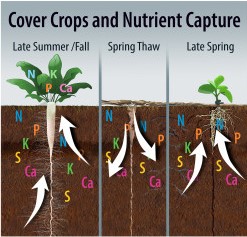Weed control, nutrient management and six more perks of planting cover crops
Cover crops provide numerous benefits for the soil, including reduced erosion, improved ability to hold water and greater organic matter. But some soybean farmers still aren’t sure whether they’ll return the investment. According to Keith Berns, Ray Gaesser and Steve Groff who grow soybeans in Nebraska, Iowa and Pennsylvania, respectively, they pay in more ways than one. Here are eight cover crop benefits.

- One way to convert cover crops into dollars is through animals. Berns says cover crops planted late in the summer can provide grazing ground for cattle all winter long.
- Cover crops keep costly nutrients from escaping into the water. “We paid for them; we need to stop the leaks and keep them in our field where they belong,” says Groff. In fact, the earlier you plant the cover crop, the more nutrients it will absorb.
- Gaesser’s farm in southwest Iowa has received 4 inches of rain in less than an hour at least once each year since 2010. He says his farm wasn’t able to handle that much moisture – until he started planting cover crops. “We have extreme rainfall events,” says Gaesser. “When we started planting cover crops, we eliminated erosion that was a result of those rains.”
- The roots of a Tillage Radish® – when planted early enough – can stretch more than 6 feet into the ground. So that plant can pull deep-lying nutrients closer to the surface, where cash crops can use them. Additionally, cover crops in general make potassium and phosphorus more available, Groff says. And cover crops in the legume family produce nitrogen for subsequent crops to use.
- Cover crops make a crop rotation more diverse. That leads to more diversity of insects, most of which are beneficial for production, such as pollinators and predatory insects that feed on insect pests. For every one harmful insect for agriculture, there are 1,700 beneficial bugs, Berns says.
Click here to see more...